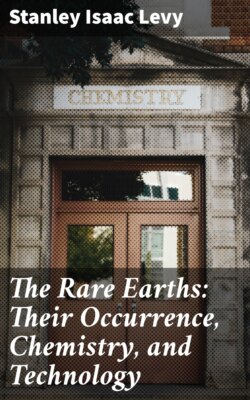Читать книгу The Rare Earths: Their Occurrence, Chemistry, and Technology - Stanley Isaac Levy - Страница 166
На сайте Литреса книга снята с продажи.
Zircon.
Оглавление—Zircon is a silicate of zirconium, ZrSiO₄, with small quantities of other elements. Most varieties contain ferric oxide and thoria; more rarely small proportions of the yttria earths may be present. All varieties contain traces of a large number of the common metals. Traces of radium are usually present, with helium and neon,[50] and the mineral is strongly radioactive.
[50] Strutt, Nature, 1906, 102.
System tetragonal, holosymmetric sub-class. c = 0·6404; (001) ∧ (101) = 32° 38´.
Usual forms—Prisms a {100} and m {110}; pyramids e {101}, p {111}, u {221} and x {311}, etc. The basal pinakoid c {001} is rare. The usual combination is one or both of the prisms a, m, with one or two pyramids. Twinning is rare, the twin plane being e (101), giving knee-shaped twins similar to those so characteristic of cassiterite and rutile. Cleavage ∥ m imperfect, ∥ p bad.
Brittle; conchoidal fracture. Hardness 71⁄2; sp. gr. usually 4·68-4·70, but varying from 4·2 to 4·86. Adamantine lustre. Clear and colourless to yellow-, red- or greenish-brown. Transparent to opaque. Refraction and double refraction strong, double refraction positive (ω = 1·924, ε = 1·968, for sodium light); on heating it becomes biaxial, and occasionally is found biaxial in nature. By alteration it becomes isotropic.
It is infusible before the blowpipe, but loses its colour; some varieties glow and increase in density (see p. 38). In some varieties also the colour changes or disappears rapidly on exposure to sunlight, and is often restored on keeping in the dark. These phenomena of colour change have been attributed variously to alteration in the state of oxidation of the iron present, and to the presence of organic matter. It seems probable that either cause or even both may be at the root of the change in particular cases.
On account of the hardness, unalterability, and strong refraction and double refraction, good crystals of zircon are used as gems. The two gem varieties, Hyacinth and Jargon, are found chiefly in the gem gravels of Ceylon. It was in a zircon from Ceylon that Klaproth discovered the new earth, Zirconia, in 1789.[51] In 1795 he found the same earth in hyacinth, and so showed the two to be identical.
[51] Schriften der Gesellschaft naturforschender Freunde in Berlin, 1789, vol. 9.
Artificial crystals of zircon have been obtained by the action of silicon tetrachloride and silicon tetrafluoride on zirconia, and by the action of zirconium tetrafluoride on silica at high temperatures.
Zircon is one of the most widely distributed minerals known, though usually it occurs in very small quantities. Good crystals have been found in New Zealand, in Ceylon, at Miask in the Urals, and in North Carolina. This last deposit has been worked commercially for the extraction of zirconia for Nernst lamps (vide p. 320). It occurs in a decomposed felspar in a pegmatite dyke in the Archæan gneiss near Zirconia, Henderson Co., and can be easily extracted by picking or washing, after crushing if necessary. Should there ever be a considerable demand for zirconia, it could doubtless be saved as a by-product in the extraction of thoria from monazite sands (q.v.), zircon being very generally found in those sands (see below).
Zircon is common in crystalline rocks, limestones, schists, syenites, granites, etc. It is a constant accessory constituent in the acid igneous rocks, especially in the more acid eruptive rocks. It is readily detected under the microscope by the pleochroic haloes with which the tiny crystals are surrounded; these have been shown by Joly to be due to alteration of the surrounding rock by the radiations emitted by the radio-active constituents of the zircon. It also occurs as a constituent of those sands which are formed by the erosion of the igneous rocks in which it is enclosed, and hence it almost invariably accompanies monazite in the so-called monazite sands.
Zircon is one of the least easily altered minerals; by the prolonged action of chalybeate and other waters, during many geological ages, however, it gradually changes, losing silica and gaining lime, oxides of iron, and water. Some of these altered varieties have received special names, as, e.g. Auerbachite, Malacone, Cyrtolite, and Alvite; but none of them is of special interest.
